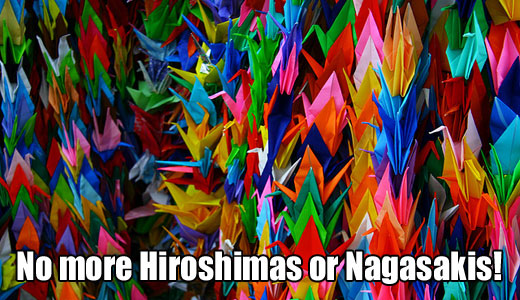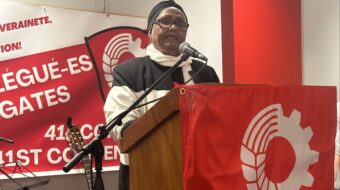
The following article is reprinted from August 9, 2012.
The United States dropped an atomic bomb on Nagasaki, Japan, Aug. 9, 1945, three days after the bombing of Hiroshima, the only two cases of using a nuclear weapon against civilians.
Approximately 140,000 people were killed immediately from the bomb blast on Hiroshima on Aug. 6, while 90,000 people were lost in the city of Nagasaki. Tens of thousands later died from cancer and other long-term effects from the bomb blasts.
From the horrendous rubble, a worldwide peace movement emerged to ban nuclear weapons around the world. Atomic bomb survivors also organized and take part in the demand “For a Nuclear Weapon-free, Peaceful and Just World.”
Many in the labor movement see the issues of war and peace, voracious spending on armaments, detrimental to the economic and security interests of all working people in the United States and globally. U.S. Labor Against the War participated in one of last year’s commemorations of Nagasaki and Hiroshima.
In Japan, an anti-nuclear movement has emerged in the wake of the horrendous earthquake/tsunami and the subsequent disaster at Fukushima nuclear power plants.
In 2012, the commemoration in Hiroshima was attended by Clifton Truman Daniel, a grandson of President Harry Truman, who made the decision to drop the atomic bombs.
Los Angeles Japanese News Daily Rafu Shimpo reported that Daniel had met “an elderly man whose name is Sasaki Masahiro, whose sister died from leukemia when she was 12 years old, a victim of the atomic bomb in Hiroshima…”
Daniel promised him that he would visit Hiroshima, the newspaper reported.
Sasaki’s sister was “Sadako Sasaki, who is remembered for attempting to fold 1,000 origami cranes before her death in 1955. Her statue stands in Peace Memorial Park, adorned with paper cranes sent from around the world.”
Daniel told the media “It’s now my responsibility to do all I can to make sure we never use nuclear weapons again,” he said.
The U.S. ambassador to Japan attended the 2012 year’s commemoration. During the Obama administration, an American ambassador attended the annual commemoration for the first time in 2010. The president has pursued a nuclear weapons’ policy that could lead to a substantial reduction of nuclear weapons.
According to The Japan News, today, August 5, 2013, U.S. Ambassador to Japan John Roos attended the ceremony for his third time.










